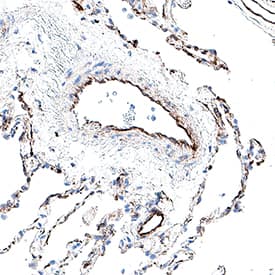Human Cadherin-9 Antibody
R&D Systems, part of Bio-Techne | Catalog # MAB11589

Key Product Details
Species Reactivity
Applications
Label
Antibody Source
Product Specifications
Immunogen
Gly54-Ala615
Accession # Q9ULB4
Specificity
Clonality
Host
Isotype
Scientific Data Images for Human Cadherin-9 Antibody
Detection of Cadherin-9 in Human Lung.
Cadherin-9 was detected in immersion fixed paraffin-embedded sections of human lung using Mouse Anti-Human Cadherin-9 Monoclonal Antibody (Catalog # MAB11589) at 5 µg/ml for 1 hour at room temperature followed by incubation with the Anti-Mouse IgG VisUCyte™ HRP Polymer Antibody (Catalog # VC001). Before incubation with the primary antibody, tissue was subjected to heat-induced epitope retrieval using VisUCyte Antigen Retrieval Reagent-Basic (Catalog # VCTS021). Tissue was stained using DAB (brown) and counterstained with hematoxylin (blue). Specific staining was localized to the cell surface. View our protocol for IHC Staining with VisUCyte HRP Polymer Detection Reagents.Applications for Human Cadherin-9 Antibody
Immunohistochemistry
Sample: Immersion fixed paraffin-embedded sections of human lung
Formulation, Preparation, and Storage
Purification
Reconstitution
Formulation
Shipping
Stability & Storage
- 12 months from date of receipt, -20 to -70 °C as supplied.
- 1 month, 2 to 8 °C under sterile conditions after reconstitution.
- 6 months, -20 to -70 °C under sterile conditions after reconstitution.
Background: Cadherin-9
Cadherin-9 (CDH9) is a member of the larger Cadherin superfamily of cell surface glycoproteins originally identified as proteins mediating cell-cell adhesion (1). In humans, there are more than 100 cadherin members divided into distinct families and numerous sub-families (1-3). Cadherins share a general structural architecture with an extracellular domain (ECD) containing 2 or more extracellular Ca2+ binding cadherin repeat (EC) domains, a single-pass transmembrane section, and a short cytoplasmic tail (1-3). Cadherins function by forming homophilic binding interactions through these EC domains to generate both trans and cis dimers (1-3). Human CDH9 is categorized as a classical cadherin, containing 5 EC domains, and the ECD shares 94% amino acid sequence identity with the ECD of both mouse and rat CDH9, respectively. Cadherins are found in diverse cell types and have been implicated as essential for the morphogenesis and homeostasis of multiple tissues and organs (1-3). Human CDH9 functions primarily in the central nervous system and is expressed in DG and CA3 neurons. Loss of CDH9 expression leads to defects in synapse formation and differentiation of specific neural circuits. (4). Additionally, disruption to CDH9 and CDH10 genes has been linked to autism spectrum disorders (5, 6). CDH9 expression has been identified in human kidney, and it has been used as a cell surface marker for fibroblasts (7). Recently, CDH9 has been reported as a potential suppressor of cancer metastasis (8).
References
- Gumbiner, B.M. (2005) Nat. Rev. Mol. Cell Biol. 6:622.
- Hirano S and Takeichi M. (2012) Physiol Rev. Apr; 92(2):597.
- Nollet et al. (2000) J Mol Biol. Jun. 9; 299(3):551.
- Williams ME et al. (2011) Neuron. Aug. 25; 71(4):640.
- Wang K. et al. (2009) Nature 459, 528.
- Inoue YU and, Inoue T. (2016) Sci Rep. 6:31227.
- Thedieck, C. et al. (2007) PLoS One. 2(8):e657.
- Yan G. et al. (2017) Scientific Reports volume 7, 10023.
Alternate Names
Gene Symbol
UniProt
Additional Cadherin-9 Products
Product Documents for Human Cadherin-9 Antibody
Product Specific Notices for Human Cadherin-9 Antibody
For research use only
